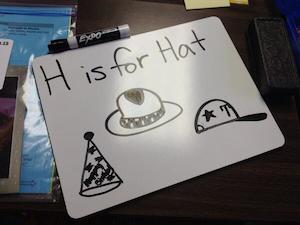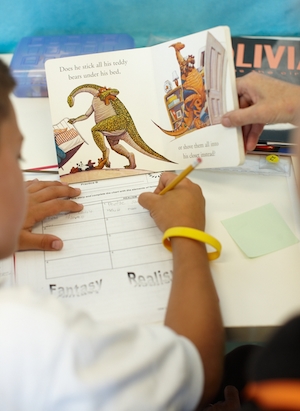May 13, 2016
What I learned tutoring a kindergartner through Reading Partners

Originally published on LinkedIn.
This past semester, I had the privilege of tutoring with Reading Partners, a nationally recognized educational nonprofit that empowers students to reach their full potential. Living in San Francisco, I’ve often felt pressure to always be doing something big and amazing to change the world. To make a difference though, you don’t have to change the world—you can start with the community you live in. I had a wonderful experience with Reading Partners, and here are some of the lessons I learned while tutoring a kindergartener named Allan.
 1. Make it fun. Learning is much easier when it’s fun and interactive. To review and learn letters of the alphabet, Allan and I would use the whiteboard to write letters and sound them out, and then we would practice making the letters with Play-Doh. To make it more fun and challenging, I used a sand timer as we made the letters together. This turned it into a game to see if we could both make our letters before the timer ran out. Allan really wanted to play tic-tac-toe, so I turned it into a learning opportunity. I let him draw the tic-tac-toe board, and then I’d write a letter in each box. Before placing an X or an O in a box, Allan would have to say the letter, sound it out, and tell me a word that started with the letter. This way, he was able to play one of his favorite games and also review the letters of the alphabet.
1. Make it fun. Learning is much easier when it’s fun and interactive. To review and learn letters of the alphabet, Allan and I would use the whiteboard to write letters and sound them out, and then we would practice making the letters with Play-Doh. To make it more fun and challenging, I used a sand timer as we made the letters together. This turned it into a game to see if we could both make our letters before the timer ran out. Allan really wanted to play tic-tac-toe, so I turned it into a learning opportunity. I let him draw the tic-tac-toe board, and then I’d write a letter in each box. Before placing an X or an O in a box, Allan would have to say the letter, sound it out, and tell me a word that started with the letter. This way, he was able to play one of his favorite games and also review the letters of the alphabet.
2. Try a new approach. My dad used to tell me, “Andrew, you don’t really know something until you can teach it to someone else and make it simple and easy to understand.” Whether trying to explain words that rhyme, breaking down words into syllables, or teaching new letters of the alphabet—I found that in most cases when Allan didn’t understand a concept, it was because I wasn’t explaining it well enough. When I adjusted my teaching approach—using games, drawing pictures, or just trying to make a concept simpler to understand, Allan usually caught right on.
3. Exercise patience. “Wait, don’t tell me!” I couldn’t help but smile and feel a sense of pride the first time Allan said this to me. We were reviewing the letter D, and I asked him to give me a word that started with the letter. After a few seconds without a response, I was ready to provide an answer for him. After asking me to wait, Allan sat there for another few seconds and proudly exclaimed, “Dolphin!” Initially, I would only wait a few seconds after asking Allan a question before I would jump in to give him a hint, or sometimes the answer. I found that exercising a little patience created space for him to succeed—and he usually found the right answer on his own.
 4. Correct through example. You don’t always have to make direct corrections. When we would play tic-tac-toe to learn letters, Allan would always say to me, “I’m going to win you Andrew.” Instead of immediately correcting him and telling him that he was wrong, I started responding with, “I don’t know Allan, I’m pretty good at this game. I don’t think you’re going to beat me.” He’d always smile back at me and say, “Yes, I’m going to beat you.” After doing this for a few sessions, Allan eventually learned the proper way to say he was going to beat me. Which he did—when I let him of course.
4. Correct through example. You don’t always have to make direct corrections. When we would play tic-tac-toe to learn letters, Allan would always say to me, “I’m going to win you Andrew.” Instead of immediately correcting him and telling him that he was wrong, I started responding with, “I don’t know Allan, I’m pretty good at this game. I don’t think you’re going to beat me.” He’d always smile back at me and say, “Yes, I’m going to beat you.” After doing this for a few sessions, Allan eventually learned the proper way to say he was going to beat me. Which he did—when I let him of course.
5. Provide specific praise. Giving praise helps build confidence, and provides encouragement for continued learning. But I found that it’s important to be specific with your praise. Instead of simply saying, “Great job today Allan,” I started giving him specific praise. “Great job today Allan, you did really well sounding out the letters C and D, and telling me a word that starts with each letter.” After giving specific praise, Allan was able to remember the lesson better, and explain what he had learned for the day.
Andrew Hutchinson is an Army veteran who served in Iraq and Afghanistan. He currently works for Team Red, White & Blue, one of the fastest growing veteran support nonprofits in the country. He’s passionate about fitness and health, community, and empowering others.












